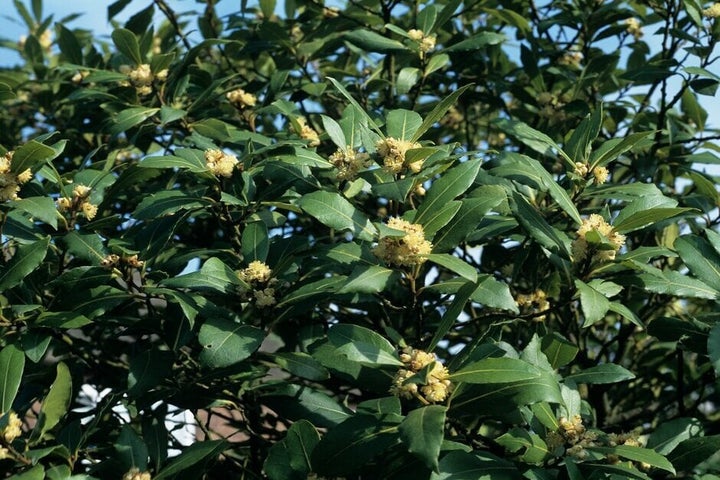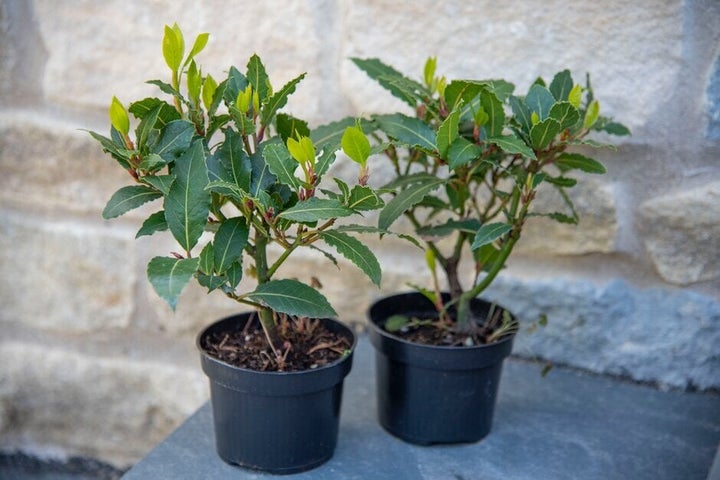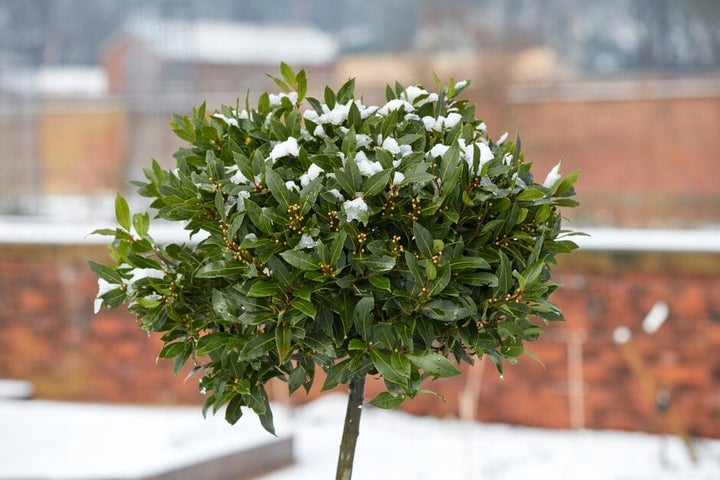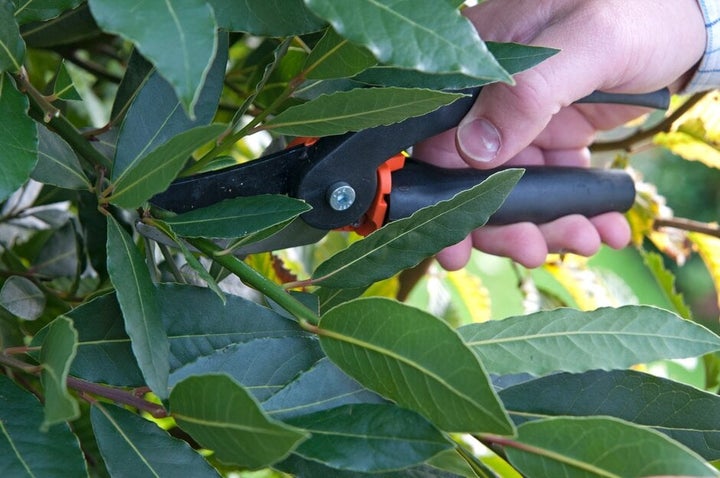Getting Started

Bay is a Mediterranean evergreen shrub or small tree. Its aromatic leaves can be harvested all year round to flavour a wide range of dishes. It adds form and structure to a herb garden, where it can be clipped into formal shapes or left to grow naturally.
Bay (Laurus nobilis) – also known as sweet bay or bay laurel – has dark green, glossy, evergreen leaves. These can be added to soups, stews and many other slow-cooked dishes. They don't soften much when cooked, so should be removed before serving. Bay is the key ingredient of bouquet garni. Its leaves impart a warm background flavour, either used fresh for more pungency or dried for subtler tones.
Bay grows well in a container or in free-draining soil, in a warm, sheltered, sunny or partly shaded spot. Keep it out of strong winds and avoid planting in damp ground.
As well as being used as a herb, bay is often grown astopiary for ornamental appeal – usually clipped into a pyramid, cone, ball, or standard (lollipop-shaped small tree). Bay topiary looks great in pots on either side of a doorway or as a focal point in a herb garden. Provided it's not trimmed too often, bay will produce clusters of pale yellow flowers in spring, which are excellent for attracting pollinators. When planted in the ground, bay can eventually become large – reaching at least 10m (33ft) tall – but can easily be kept at a manageable size by pruning.
Jobs to do now
Harvest
Protect from cold if needed
Month by Month
Plant
Harvest
Choosing What To Grow
Most bay plants sold in the UK are Laurus nobilis, with dark green, pointed leaves. Two other forms, both with aromatic leaves that can be used in cooking, are often available from specialist herb or shrub nurseries:
- Laurus nobilis ‘Aurea’ – golden bay, with yellow leaves that are especially vibrant in winter and spring
- Laurus nobilis f. angustifolia – willow-leaved bay, with narrow, wavy-edged, green leaves
When choosing a bay, look for one with an RHS Award of Garden Merit (AGM), which shows they performed well in trials. See our list of AGM ornamental plants (975kB pdf) under Laurus, and our Recommended Varieties below. You’ll also find a wide range of herbs, including bay, in the RHS gardens, so do visit to compare varieties and different aromas, and pick up growing tips and inspiration.
What and where to buy

Bay is widely sold by garden centres and online retailers as young potted plants, larger free-growing shrubs and pre-trained topiary shapes. It may be found in the ‘herbs’ and/or ‘shrubs’ areas of garden centres and mail order listings. Trained or topiary plants can be fairly expensive, as the process can take some time, but you could create bay topiary yourself from an untrained plant.
Recommended Varieties

Willow-leaved bay AGM
L. nobilis f. angustifoliahas narrow, wavy-edged, pale green, aromatic leaves.

Golden bay AGM
L. nobilis 'Aurea' has yellow-tinged, aromatic leaves, at their brightest in winter and spring.
Planting
Bay can be planted in the ground or in a container, ideally in a warm, sheltered location, in full sun or light shade.
Planting in the ground
Bay is best planted in the ground in spring, when the soil is starting to warm up and it will have a full to establish before winter. Bay needs free-draining soil that doesn’t get . No soil preparation is generally needed before planting. However, if your soil is poor, mix some organic matter, such as garden compost, into the soil you remove from your planting hole and use this to backfill after planting. This minimises soil disturbance and helps your plant get off to a strong start.
If planting a bay trained as a large standard into the ground, it will benefit from being staked for at least the first year.
Planting in containers
Bay is an ideal plant for containers – so it can still be grown in gardens with heavy, wet soil or in particularly cold areas where it can be moved into a greenhouse during winter. Select a container that's slightly larger than the one your newly purchased bay came in and be prepared to pot on young plants every couple of years (see Repotting below). Use a good quality loam-based such as peat-free John Innes No 2 or No 3 and ideally mix in some horitucultural grit to improve drainage and stability. See our video and guides below for more information on planting in containers.
Plant Care
Bay is generally low maintenance, though it may need winter protection in colder regions. It can be clipped annually to maintain a neat, compact shape or pruned more heavily to reshape or reduce its size. Bay is often grown in containers, in which case it needs regular watering and feeding too.
Watering
Water newly planted bay in dry spells during the first year. Once established in the ground, bay shouldn’t need watering. When growing in a container, check the moisture levels regularly, especially during summer, and water if needed. Make sure the doesn’t become , especially in winter, otherwise the roots may rot.
Feeding
Bay growing in the ground shouldn't need any additional feeding. However, you can add some to the soil by with well-rotted organic matter, such as garden , in late winter or early spring. Mulching will also improve soil structure, help to retain moisture and suppress weeds.
Plants in containers will benefit from an organic-based, general purpose liquid fertiliser applied every two or three weeks from mid-spring to late summer.
If plants in containers or in the ground aren't thriving and their leaves begin to discolour, check our page on nutrient deficiencies to determine whether a nutrient is lacking. Then apply the recommended feed, following the instructions on the packet.
Winter protection

Bay likes free-draining soil and a warm, sheltered site, especially in winter. Harsh frosts and cold winds can damage the foliage, kill some or all of the top growth, and in extreme cases, kill the whole plant. Cold, damp soil can also cause the roots to rot. If a harsh frost is forecast, cover smaller bay plants with biodegradable fleece, hessian or an old bedsheet overnight.
Plants in containers are particularly vulnerable to winter cold and damp. Prolonged low temperatures can lead to the and roots freezing in the pot. Prevent this happening by grouping pots together, wrapping old blankets or reused bubble wrap around the pot, or move them to a warmer, more sheltered spot—such as a greenhouse, porch, or the lee of a wall.
Repotting
Bay growing in a container benefits from being repotted every two or three years. Use a slightly larger container and fresh peat-free . If your bay is in a large container and it's not feasible to go up a container size, you can prune the roots, refresh the and pot it back into the same container. See our guides below for more details.
Propagating
Bay can be propagated in three ways:
- Cuttings – take semi-ripe cuttings in late summer or softwood cuttings in early summer. This is the simplest and fastest way to make new plants
- Layering – select a suitably low-growing branch and peg it down into the soil. Autumn is a good time to layer branches. Layering is usually successful but can take up to a year to produce a new plant
- Seeds – bay can be slow and tricky to grow from seed, but if you have a mature female bay, you may get self-sown
Pruning And Training

Topiary bay should be trimmed in summer to keep it in good shape and encourage denser growth. Ideally use secateurs or loppers, as using hand shears or hedge trimmers creates cut leaf surfaces that look unsightly. With standard (lollipop-shaped) bay trees, suckers may sprout from the roots. To keep just the single clear stem, pull out these shoots as soon as you spot them.
If growing bay as a free-form shrub, simply shorten new growth where necessary in spring or summer. Bay generally responds well to hard pruning, which is best done in mid- to late-spring. If any shoots are damaged byfrost over winter, cut out the affected areas in spring.
Harvesting
Bay is evergreen, so it keeps its leaves all year round and they can be harvested whenever required. They can be used fresh or dried – fresh leaves have a stronger, slightly bitter flavour, so leaves are more often dried to soften and enhance the flavour. Bay leaves add subtle warm tones to slow-cooked stews, soups, stocks and sauces. Remove them before serving.
To dry bay leaves, you can simply place sprigs or individual leaves in a warm room. To flatten leaves (making them more compact and easier to store whole), dry them between the pages of an old paperback with a weight on top. Once fully dry, place the leaves in an airtight jar or similar container and use within a few months, before the flavour starts to fade. Growing your own bay means you can easily dry a sprig or two regularly, so you always have plenty of aromatic leaves to hand. Alternatively, freeze them to keep the flavour for longer.
Problem Solving
Bay is susceptible to winter cold and wet, so grow it in a warm, sheltered spot and cover with hessian, or an old bed sheet if a harsh frost is forecast. Damp soil or , especially in winter, can rot the roots.
Spotted or yellowing leaves may indicate that the roots are too damp or that a containerised plant needs to be repotted.
Also look out for bay suckers and scale insects – see Common problems, below.
Common Problems

Frost damage
Frost can affect many plants, and is particularly damaging to tender new growth and blossom in the spring. The risks of frost damage can be reduced by...

Bay sucker
Bay sucker can cause discolouration and distortion of leaves at the shoot tips of bay laurel.

Scale insects
Adult scale insects are usually covered in waxy shell-like cover. There are more than 25 species of scale insect found in British Gardens. Each specie...



